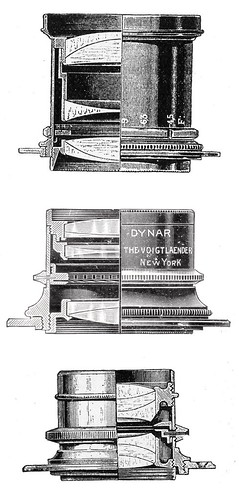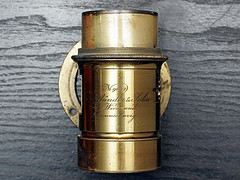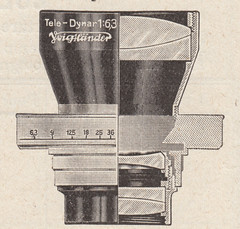Voigtländer
Voigtländer was one of the the world's longest-lived camera and lens makers. The brand is still used by other firms.
|
|
|
Company history
Voigtländer was founded in 1756 in Vienna, Austria by Johann Christoph Voigtländer, as a scientific instrument maker. Voigtländer was an optician and inventor, noted for his work on mathematical instruments, and held letters patent (a state-protected monopoly, the forerunner of a Patent) from the Austrian government, granting an exclusive right to carry on that business. For example, Voigtländer invented instruments for linear and circular measure (i.e. to measure and divide distances and angles with great precision) which were used for calibrating surveying and navigational instruments including astrolabes.[1]
Voigtländer died in 1797, and the company passed to his widow and two eldest sons, Wilhelm and Siegmund. Another son, Friedrich Voigtländer, took control in 1808.
In the 19th century, Voigtländer made optical products including opera glasses and periscopic lenses. In 1840, the Hungarian Josef Petzval designed the innovative Petzval lens for Voigtländer. The lens, with the widest relative aperture of any then made (about f/3), was very successful for its intended purpose: the making of daguerreotype portraits.[2] The wide aperture allowed a very considerable reduction in exposure times. The lens' main limitation (it only covers a narrow field of view) prevented it being adapted for other uses (landscape, for example), but does not matter for portraiture. The design was widely adopted, and Petzval lenses were made for about the next century. Voigtländer also made cameras, including the first all-metal daguerrotype camera.
In 1849 Voigtländer built a branch factory in Braunschweig (Brunswick) in Germany under the name Voigtländer & Sohn, Optical Institute, and in 1862 the company moved its headquarters to Braunschweig. In 1898 the company, until then family-owned, became a public company (i.e. sold shares on the stock market, becoming Voigtländer AG).[3] By 1915 the company had outgrown its buildings and moved to new premises in another part of Braunschweig. Unsurprisingly, the company made some military products during the First World War.[4]
Voigtländer remained independent after the War, when hard times (due in part to the effects of War reparations on Germany's economy) caused some other firms to enter mergers. In 1920, Rudolf Heidecke and Paul Franke, employees of Voigtländer, left the firm to form Franke & Heidecke (their first camera, the Heidoscop, bears a striking similarity to Voigtländer's Stereflektoskop; Heidecke was a designer, and it seems likely that he either had rights to this design, or had Voigtländer's blessing to use it). In 1925, Schering AG (a chemicals company) bought a majority share in Voigtländer. The company expanded its premises again in 1929. It was in the period of Schering's ownership that many of the familiar Voigtländer cameras were made, including the first Bessa. Voigtländer again made military equipment (including but not limited to aerial reconnaissance cameras, binoculars and rifle scopes) for Germany's rearmament and the Second World War, but continued development of cameras at least up to shortly before the War itself; the Bessa 466 was designed around 1938 (Voigtländer's British patent for this innovative camera was finalised in 1940, actually during the War)! During this time parts of production were moved to the Wolfenbüttel district (still on the outskirts of Braunschweig), where prisoners of war were employed.
In 1956 Schering sold its shares in Voigtländer to Carl Zeiss.
Lenses

|
| Petzval lens (Image rights) |

|
| Lenses: Heliar, Dynar and Kollinear (Image rights) |
Despite the successful early metal camera designed by Voigtländer lenses were the company's main contribution to early photography in the 19th century. And the success of Voigtländer's camera lines of the 20th century was based on the quality of its lenses. At the turn from the one to the other century Voigtländer had a branch office in New York, Voigtlander & Son Optical Co. . It advertised Voigtländer lenses like the Dynar for usage with the better Kodak cameras.
The beginning was made with the Petzval lens which became a timeless standard lens for portrait photography. It is Voigtländer's great lens design of the company's days in Austria. Many cameras of renowned or unknown makers were equipped with Voigtländer lenses, mainly with the fast Petzval lens since portrait cameras were the butter-and-bread tools of the photographers. The lens had four elements, divided in two groups. The two front elements were glued together, the two back elements just placed close to each other. The lens had a characteristic vignetting and curvature of field, but it made images which were very sharp in the centre.
At the turn to the 20th century Voigtländer switched to another fast lens design, the Heliar, a symmetric lens invented by Carl August Hans Harting in 1900, improved by him as asymmetric lens in 1902. Other fine lens designs of that time were the Dynar and Kollinear lenses.
During the 20th century the Skopar and Color Skopar lenses became the standard lenses for Voigtländer's own cameras.
A milestone in camera lens making was the Zoomar, the world's first interchangeable zoom lens.

|

|
| No. 9643 images by Siim Vahur (Image rights) |

|
| Tele-Dynar images by Dirk HR Spennemann (Image rights) |
Lenses
- Apo-Lanthar
- Collinear / Kollinear f/6.3
- Color Skopar
- Dynar f/5.5
- Dynaron
- Heliar f/4.5
- Lanthar
- Petzval portrait lens
- Radiar
- Skopar
- Skoparon
- Tele-Dynar f/6.3
- Voigtar f/6.3
- Zoomar
See here for dating the serial numbers of Voigtländer lenses.
Cameras
Early cameras
- 1840: Daguerreotyp-Apparat zum Portraitiren
- 1890: Reisekamera
- 1900: Reisekamera Typ A
- Reisekamera Tropical
35mm SLR

|
| Bessamatic image by Rick Soloway (Image rights) |
35mm RF, interchangeable lens
35mm folding
35mm fixed lens

|
| image by inetjoker (Image rights) |
* Vito B, small or big finder
- Vito BL
- Vito BR
- Vitomatic I
- Vitomatic II
- Vitomatic Ia
- Vitomatic IIa
- Vitomatic Ib
- Vitomatic IIb
- Vitomatic IIIb
- Vitomatic ICS
- Vitomatic IICS
- Vitomatic IIICS
- Vito C
- Vito CD
- Vito CL
- Vito CLR
- Vito CS
- Vito CSR
- Vito Automatic
- Vito Automatic I
- Vito Automatic II
- Vito Automatic F and R
- Dynamatic
- Dynamatic II
- Vitoret
- Vitoret F
- Vitoret R
- Vitoret L / LR
- Vitoret D / DR
- Vitoret Rapid D
- Vitrona
120 folding
- Inos I (6×9)
- Inos II (6×9) (6.5x11)
- Virtus (4.5×6)
- Prominent (6×9)
- Bessa (prewar) (6×9)
- Bessa RF (6×9)
- Bessa I (6×9)
- Bessa II (6×9)
- Bessa 46 (4.5×6)
- Bessa 66 (6×6)
- Perkeo (6×6)
- Perkeo II (6×6)
- Perkeo E (6×6)
- Rollfilmkamera (6×9)
120 TLR
127 folding
- Perkeo (3×4)
Folding plate cameras
- Alpin (9x12 and 10x15) (1906-1928)
- Alpin Rapid (9x12) (1925)
- Avus
- Bergheil
- Metall-Heliar-Kamera (9x12) (1903-1920)
- VAG
Reflex cameras
- 1905: Heliar Reflex (9x12 cm)
- 1908: Bijou ('Miniatur-Reflex-Kamera'; 4.5x6 cm)
- 1912: Spiegel-Reflex-Kamera
Stereo cameras
- 1902: Stereoskop
- 1904: Stereophotoskop (4.5×10.7 cm plates)
- 1905: Stereo and Panorama Kamera (9×14)
- 1911: Alpin Stereo (10×15)
- 1912: Spiegelreflex-Stereo
- 1914: Stereflektoskop (6×13 cm)
Zeiss Ikon / Voigtländer
35mm SLR
For the Icarex line, see Zeiss Ikon.
35mm fixed lens
- Vitessa 500 L / 500 S / 500 AE electronic / 500 SE electronic / 1000 SR
126 film viewfinder
- Bessy k/ak/as/s
- Vitessa 126 CS / 126 electronic / 126 S electronic
Voigtländer (Rollei)
35mm SLR
With 42mm screw lenses:
- VSL 1 (TM)
- VSL 2CX automatic (prototypes)
With Rolleiflex SL35 lenses:
- VSL 1 (BM)
- VSL 2 automatic
- VSL 3-E
- Vitoflex E (prototypes)
35mm rangefinder
- VF 101 (1974–76)
- VF 102 (1974, prototype)
- VF 135 (1976–80)
- VF 35F (1981)
- XF 35 (1981)
Intermediate period
35mm
- Vito
- Vito C
- Vito CS
- Vito C-AF
110 film pocket camera
- Vitoret 110 (1976–81)
- Vitoret 110 EL (1976–81)
Cosina and Ringfoto
Long after the demise of the original Voigtländer company, the brand was re-used by Ringfoto and Cosina.
Notes
- ↑ For example, Christie's in London sold a brass alidade by W. Voigtländer of Vienna (one of J.C. Voigtländer's sons) in June 2000. An alidade is a surveying instrument for measuring or marking the horizontal angle of sighted landmarks.
- ↑ Greenleaf, Allen R. Photographic Optics. Macmillan, New York, 1950. p67-8.
- ↑ Thus British Patent 18157 of 1897, Improvements in Photographic Objectives, is in the name of Friedrich, Ritter von Voigtländer, while US Patent 716035 of 1902, Lens, is in that of Voigtländer & Sohn Aktien Gesellschaft; both patents at Espacenet, the patent search facility of the European Patent Office.
- ↑ For example, Voigtländer binoculars at PBase.
Links
- Voigtländer.de Manufacturer's site (German & English)
- An Article on the Heliar Lens
- Voigtländer Verein Club
- Some 40 Voigtlander instruction manuals in English, scanned in PDF format, 600 dpi
- Voigtländers on ukcameras
- Voigtländer illustrated history
- Voigtländer Cameras Price Guide at CollectiBlend
- Voigtlander instruction manuals - English at Orphancameras.com
- Voigtländer Camera Manuals : Photo-Manuals.com by Ben Squire
- Ollinger's History of Voigtländer
In French :
- Cameras and user manuals at Sylvain Halgand's www.collection-appareils.com
- Voigtlander page at Collection G. Even's site
In German :





